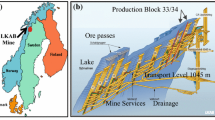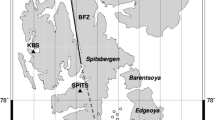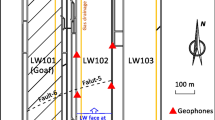Abstract
During the last thee years, the MINE project has developed and successfully applied seismological tools, addressing different aspects of the monitoring of mining environments, as dynamic local-scale systems. The human interaction with the shallow underground mining environment, can lead to rock mass weakening or locally induce stress perturbations. As a consequence, triggered or induced seismicity is often observed at mines, potentially posing a risk to miners and infrastructures. This work illustrates a number of recently developed seismological techniques, based on the analysis of full waveforms, which target the problem of detection, location, and characterization of mining-induced seismicity. The proposed methodologies are here discussed through their application to a 14-months coal mining dataset, affecting the region of Hamm, Ruhr, Germany. An automated full-waveform detection and location technique is first used to generate a seismic catalog. A full moment tensor amplitude spectra technique is then adapted for the analysis of induced seismicity, leading to the inversion of more than 1000 focal mechanisms. Finally, a new developed clustering algorithm is used to automatically classify source types, and to track their temporal evolution. The combined application of the methods developed within the MINE project could successfully characterise the mining-induced seismicity and its spatio-temporal variation. Our methods are suitable for automated analysis, and can be easily adopted for mining monitoring purposes in other locations, and with different network geometries.
Access this chapter
Tax calculation will be finalised at checkout
Purchases are for personal use only
Similar content being viewed by others
References
Bischoff M, Cete A, Fritschen R, Meier T (2010) Coal mining induced seismicity in the Ruhr area, Germany. Pure Appl Geophys 167:63–75. doi:10.1007/s00024-009-0001-8
Buforn E, Pro C, Cesca S, Udias A, Del Fresno C (2011) The 2010 Granada, Spain, deep earthquake. Bull Seismol Soc Am 101:2418–2430. doi:10.1785/0120110022
Cesca S, Heimann S, Stammler K, Dahm T (2010) Automated point and kinematic source inversion at regional distances. J Geophys Res 115(24):B06304. doi:10.1029/2009JB006450
Cesca S, Rohr A, Dahm T (2013a) Discrimination of induced seismicity by full moment 592 tensor inversion and decomposition. J Seismol 17(1):147–163. doi:10.1007/s10950-012-9305-8
Cesca S, Sen AT, Dahm T (2013b) Seismicity monitoring by cluster analysis of moment tensors. Geophys J Int (submitted)
Coldewey WG, Semrau L (1994) Mine water in the Ruhr area (Federal Republic of Germany). In: INWA Proceedings 1994
Custodio S, Cesca S, Heimann S (2012) Application to the 2007 Mw 5.9 Horseshoe Abyssal Plain, offshore SW Iberia, earthquake. Bull Seismol Soc Am 102:361–376. doi:10.1785/0120110125
Domingues A, Custodio S, Cesca S (2012) Waveform inversion of small to moderate earthquakes located offshore southwest Iberia. J Int Geophys. doi:10.1093/gji/ggs010
Drozdzewski G (1993) The Ruhr coal basin (Germany): structural evolution of an autochthonous foreland basin. Int J Coal Geol 23:231–250
Ester M, Kriegel H-P, Sander J, Xu X (1996) A density-based algorithm for discovering clusters in large spatial databases with noise. In Simoudis E, Han J, Fayyad UM (eds) Proceedings of the second international conference on knowledge discovery and data mining. AAAI Press, Menlo Park, pp 226–231, ISBN 1-57735-004-9
Grigoli F, Cesca S, Vassallo M, Dahm T (2013) Automated seismic event location by travel-time stacking: an application to mining induced seismicity. Seismol Res Lett 84(4):666–677. doi:10.1785/0220120191
Heimann S (2011) A robust method to estimate kinematic earthquake source parameters, PhD Thesis, University of Hamburg
Hudson JA, Pearce RG, Rogers RM (1989) Source type plot for inversion of the moment tensor. J Geophys Res 94(B1):765–774. doi:10.1029/JB094iB01p00765
Kagan YY (1991) 3-D rotation of double-couple earthquake sources. Geophys J Int 106:709–716
Kagan YY (1992) Correlation of earthquake focal mechanisms. Geophys J Int 110:305–320
Kwiatek G, Plenkers K, Dresen G (2011) Source parameters of picoseismicity recorded at Mponeng deep gold mine, South Africa: implications for scaling relations. Bull Seismol Soc Am 101(6):2592–2608
Sen AT, Cesca S, Bischoff M, Meier T, Dahm T (2013) Automated full moment tensor inversion of coal mining induced seismicity. Geophys J Int. doi:10.1093/gji/ggt300
Tape W, Tape C (2012) Angle between principal axis triples. Geophys J Int 191:813–831. doi:10.1111/j.1365-246X.2012.05658.x
Willemann RJ (1993) Cluster analysis of seismic moment tensor orientations. Geophys J Int 115:617–634
Acknowledgments
We are thankful to the Ruhr University Bochum and to all researchers involved in the installation and handling of the local network, for monitoring and providing access to data used in this study. This work has been funded by the project MINE. The project MINE is part of the R&D-Programme GEOTECHNOLOGIEN, The MINE project is funded by the German Ministry of Education and Research (BMBF), Grant of project BMBF03G0737.
Author information
Authors and Affiliations
Corresponding author
Editor information
Editors and Affiliations
Rights and permissions
Copyright information
© 2014 Springer International Publishing Switzerland
About this chapter
Cite this chapter
Cesca, S., Grigoli, F., Şen, A.T., Maghsoudi, S., Dahm, T., Meier, T. (2014). The MINE Project: Monitoring Induced Seismicity in a German Coal Mine. In: Weber, M., Münch, U. (eds) Tomography of the Earth’s Crust: From Geophysical Sounding to Real-Time Monitoring. Advanced Technologies in Earth Sciences. Springer, Cham. https://doi.org/10.1007/978-3-319-04205-3_4
Download citation
DOI: https://doi.org/10.1007/978-3-319-04205-3_4
Published:
Publisher Name: Springer, Cham
Print ISBN: 978-3-319-04204-6
Online ISBN: 978-3-319-04205-3
eBook Packages: Earth and Environmental ScienceEarth and Environmental Science (R0)




